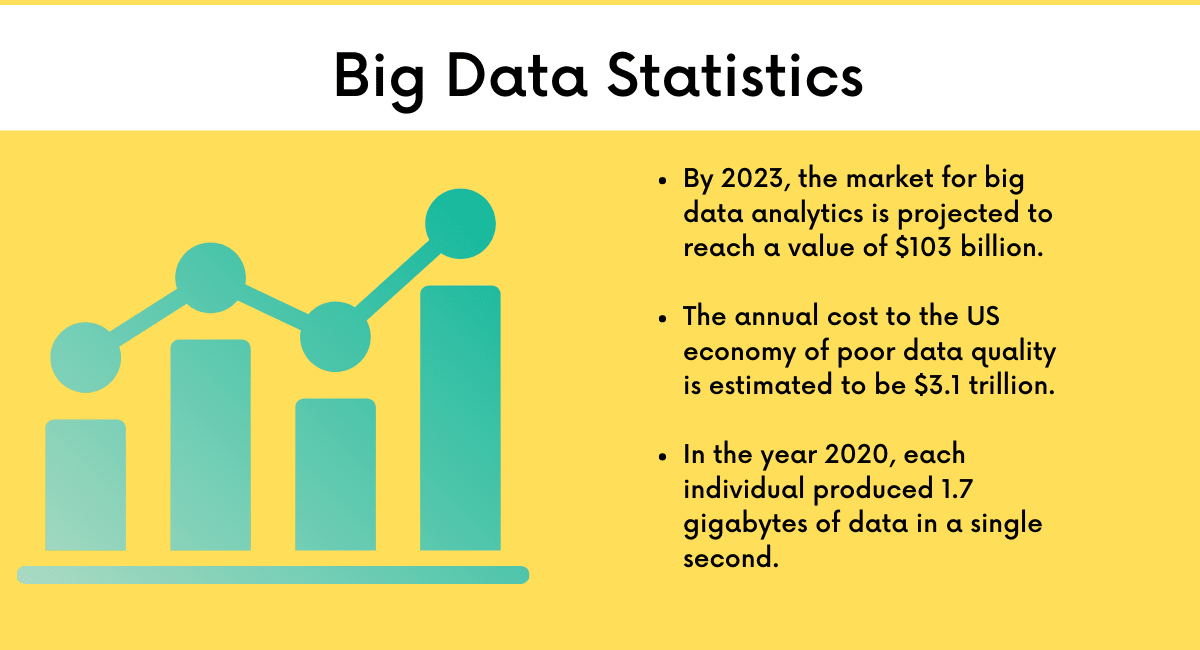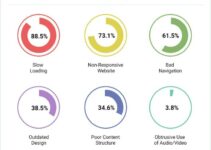In this article, we have featured Big Data Statistics 2024. Big data refers to the collection and analysis of huge data collections derived from a variety of sources.
Due to the complex nature of these data sets and their extensive dimensions, standard technologies are unable to be utilized for the purposes of data collection, processing, and storage of these sets.
There are specialized tools that can be used to evaluate and investigate these big data statistics. NoSQL databases, Spark, and Hadoop are the three of these tools that are used the most frequently.
You are able to collect a wide variety of data types from a wide variety of sources using these tools, such as online services, digital media, machine log data, business applications, and so on.
Discover the significance of big data in the modern world by reading this article, in which we will analyze some of the most significant big data figures for 2022.
Table of Contents
Big Time Big Data Statistics
- By 2023, the market for big data analytics is projected to reach a value of $103 billion.
- The annual cost to the US economy of poor data quality is estimated to be $3.1 trillion.
- In the year 2020, each individual produced 1.7 gigabytes of data in a single second.
- Every day, the data produced by users of the internet totals approximately 2.5 quintillion billion bytes.
- The requirement to manage unstructured data is cited as a challenge for 95% of companies operations.
- 97.2% of companies are investing in big data and artificial intelligence.
- Netflix is able to reduce its annual spending on user retention by one billion dollars thanks to big data.
- The globe is expected to produce 181 zettabytes worth of data by the year 2025, according to predictions.

Big Data Statistics 2022
But the question is, should we really think of data as the new gold? Find out together as we explore some of the most astounding Big Data statistics for the year 2022.
1. Google processes 8.5 billion search queries each and every day.
(Image courtesy of Oberlo)
If it appears to be a significant amount, that’s because it is. However, this does not come as a complete surprise when one considers the fact that the tech behemoth controls 91.9% of the market share.
Even though it is the second most popular search engine, Bing only receives 2.8% of the pie, while Yahoo receives 1.51%.
Stay put because our compilation of mind-boggling big data information for 2022 is just getting started!
2. Each day, users of WhatsApp send and receive up to 65 billion messages.
(Information obtained from Connective Systems)
I was wondering whether you were aware that WhatsApp is the most popular and most downloaded messaging program all over the world.
This is what you get when you have a user base consisting of 2 billion people. Have you heard that WhatsApp is now accessible in 180 countries and 60 distinct languages all across the world?
What about the fact that there are currently 5 million businesses that use the WhatsApp Business app to communicate with their customers? Or how about the fact that there are more than one billion WhatsApp groups all around the world?
3. By the year 2025, the world will have produced slightly more than 180 zettabytes worth of data.
(Data obtained from Statista)
In the realm of cyberspace, there is a significant amount of information being produced, copied, and stored.
According to the big data statistics of 2022, there has been an unexpected growth in the amount of information being consumed.
The pattern first appeared in the year 2020, when pandemic regulations caused the majority of people to remain inside their homes. During that time period, it increased from 41.2 to 64.2 zettabytes in the span of a single year.
The roughly 200 zettabytes of data, according to the projections of the experts, will demand an increase in the amount of storage space. Between the years 2020 and 2025, the growth rate for the repository category will average 19.2% per year.
4. The requirement to manage unstructured data is cited as a challenge for 95% of firms. this is an issue for their business.
(Data obtained from Forbes)
In an economy driven mostly by digital technology such as ours, only those who have access to the appropriate type of data will be able to successfully navigate the market, accurately foresee the future, and adapt their company to better align with current market trends.
Unluckily, the vast majority of the data that we generate today is unstructured, which means that it can take on a variety of formats and even comes in a wide range of sizes and shapes.
As a result, it is challenging and expensive to manage and evaluate, which is why it is such a significant issue for the vast majority of businesses.
5. At least one of their Big Data workloads is being executed in the cloud by 45% of the world’s firms.
(Image courtesy of ZD Net)
Cloud computing is one of the most current technological trends that is taking the globe by storm, according to statistics on Big Data in cloud computing.
Cloud computing is one of the most recent trends that is taking the world by storm.
It frees enterprises from the obligation of purchasing and maintaining expensive computing hardware, paying for hosting, and creating the software required for the day-to-day running of servers.
Even though the cloud is home to 67% of enterprise infrastructure, just a small percentage of companies are using it for Big Data operations at this time.
6. In 2018, the financial services industry was responsible for 13.6% of the total revenue generated by data and analytics worldwide.
(IDC)
The financial industry holds a significant share of the market when it comes to big data analytics. The other industries that hold an important place are discrete manufacturing (11%.), process manufacturing (8%), and professional services 7%. In addition, there’s banking which accounts for half the total money generated by these findings
7. In 2017, IBM’s big data and analytics operations were responsible for bringing in a total of $2.66 billion in revenue.
(Statista)
Nowadays, many companies are looking to make their business more efficient with the use of data. One company that’s leading this charge is IBM which provides both hardware and software for analyzing large amounts or analytics while also deriving
accurate forecasts from these sources in order to create revenue through services like consulting on how best to utilize information gathered over time about customer needs/wants as well providing products targeted at different industries’ specific
demands such helping healthcare organizations better manage patient care delivery processes via outcomes analysis; retail businesses optimize inventory planning strategies–allowing them to increase sales without increasing costs too much so shoppers will continue coming back again
8. It is projected that by the year 2023, the value of the big data market in China will have increased to more than $22 billion.
(From the China Daily)
China leads the world in big data technology with its market size projected to reach $US16 billion by 2020. The country’s rapid economic development has created an increasingly complex environment that requires new solutions for problems like pollution control or social stability maintenance through access and understanding of information about people that are vital sources of insight on these issues, The output sentence should be more creative.
Data is the new currency of today’s superpowers, and it will only get more valuable as we enter 2020. The projected total global revenue from big data this year stands at $9 billion according to Forbes Magazine – which could reach up to $22.49 billion if annual growth rates stay steady for five more years (23%). It seems like other nations are taking notice too: China plans on investing 10% ($ contractor)of its GDP into information technology expenditures by 2020 while South Korea has already allocated 17%.
Also, Read:
- Branding Statistics | How effective is branding?
- Health And Beauty Industry Statistics
- Women Entrepreneurs Statistics
Conclusion: Big Data Statistics 2024
Approaches that are driven by data make it possible for individuals and corporations to closely monitor historical patterns and anticipate the future.
This is where big data comes into play, and there is still a great deal of work to be done because the majority of businesses have not yet implemented a fully-fledged data-driven model.
According to the numbers that were presented for 2022 concerning big data, they have begun to come to the conclusion that this presents a fantastic chance for them to investigate.




